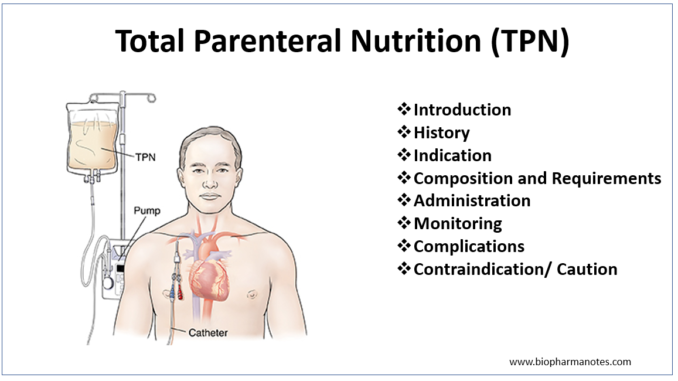
What is total parenteral nutrition (TPN)?
- When the nutrition is administered by IV route by bypassing the gastrointestinal tract, it is known as parenteral nutrition. Total parenteral nutrition term is used when IV administered nutrition is the only source of nutrients the patient is receiving.
- In normal conditions, enteral diet intake is preferred route for nutrition intake as it is easy and have fewer complications. However, in patients having gastrointestinal complications like inadequate gastrointestinal function and contraindications to enteral nutrition, parenteral route should be used.
History of total parenteral nutrition
- The first successful use of TPN in human was reported by Elman and Weiner in 1939. The use of TPN became popular after 1967.
Indications of total parenteral nutrition
- When gastrointestinal tract of patient is paralyzed and non- functional like in case of small bowel obstruction.
- In chronic intestinal obstruction as in intestinal cancer.
- In post- operative bowel anastomosis leak.
- When the patient is unable to maintain nutritional status due to severe vomiting or diarrhea.
- In hypermetabolic state such as major sepsis, polytrauma, major fractures or severe burns.
- In Chron’s disease with malabsorption and retarded or slow growth in children.
- Used in Intestinal fistula, pancreatic abscess/ fistula.
- Bowel pseudo obstruction with food intolerance.
Composition and requirements
TPN consist of mixture of all the necessary nutritional components including protein, fat, calories, vitamins and minerals. TPN solutions should be customized for each patient which depend on their age and status of organ function. The major three macronutrients are proteins, calories and lipid emulsions.
Proteins
- Specially prepared mixture of synthetic, essential amino acids are supplied via IV route. The 200 ml bottles containing 8-9% of amino acids are available for IV use.
- Critically ill patients with normal hepatic or renal function require about 1.5 gm protein/kg/day. In chronic renal patients, it should be administered in the rate of 0.6-0.8 mg/kg/day and in patients with hepatic encephalopathy, it should be administered in the rate of 0.8 mg/kg/day.
Calories
- Calories are administered as 20-25 % dextrose in water through a central vein. One gram of dextrose provides 3.4 calories.
- Other sources of carbohydrate like fructose, xylitol, sorbitol and glycerol are being studied for use in TPN. However, they haven’t received USFDA approval yet.
Fats
- Lipids are used to provide calories and to prevent essential fatty acid deficiency (EFAD). EFAD may develop within 3 weeks of fat free TPN. Some common sources of lipids in TPN are soyabean/ safflower oil, egg yolk phospholipids in 10, 20 and 30% concentration. Milky emulsions of soyabean or safflower oil in combination with emulsifying agent and glycerol are available.
- 1 ml of 10% emulsion provide with 1.1 calories. 500- 1000 ml of 10% of emulsion is injected weekly to prevent development of deficiency syndrome.
The micronutrients used in TPN are vitamins, trace elements and electrolytes.
- Multivitamin preparation which are commercially available and contains necessary vitamins like thiamine, riboflavin, niacin, biotin, ascorbic acid, cyano- cobalamin etc are administered.
- Copper, zinc, selenium and chromium are common trace elements added in TPN. The level of these trace elements are monitored monthly. Manganese and copper are not used in patients with hepatic dysfunction and selenium and chromium is not used in case of renal failure.
- Sodium 100 – 150 mEq, Potassium 50 – 100 mEq, Magnesium 8 – 24 mEq, Calcium 10 – 20 mEq and Phosphorous 15 – 30 mEq are recommended per liter of TPN solution.
Administration
- TPN is administered through central venous catheter. The two types of catheter mostly used are tunneled catheter and implanted catheter. Tunneled catheter has one segment of tube outside the skin and another portion tunneled under skin before it enters the vein. Implanted catheter is inserted completely beneath the skin.
- The catheter is placed into a large vein leading to heart after patient is anesthetized.
- Base solution of TPN consist of mixture of amino acid and dextrose which is prepared daily by mixing two solutions in laminar flow hood in hospital pharmacy. Other components like minerals and vitamins are added to this base solution.
- The starting dose is one liter of base solution per 24 hours. If the patient can tolerate this initial dose, the quantity infused is increased each day by 0.5- 1 liter. While discontinuing TPN, the amount of glucose infused should be tapered gradually.
Monitoring
- The patients on TPN should be regularly monitored until in stable condition. Some of the factors which need to be monitored are intake and output 12-hour charts, urine sugar estimate for every 8 hours, liver function test and serum protein level twice daily and serum creatinine and serum electrolytes level daily.
Complications of total parenteral nutrition
TPN may lead to various adverse effects or complications. Some of its complications are:
- TPN lipid and glucose excess may cause increased caloric amount leading to hepatic toxicity.
- Hyperglycemia.
- Electrolyte abnormalities.
- Azotemia.
- Infection at catheter insertion site.
Contraindications
It is contraindicated in following conditions:
- When gastrointestinal feeding is possible.
- In infants with less than 8 cm of small bowel.
- In patients with critical metabolic or cardiovascular instabilities.
- Irreversibly decerebrate patients.
References
- https://www.ncbi.nlm.nih.gov/books/NBK559036/
- https://www.ncbi.nlm.nih.gov/pmc/articles/PMC2900762/
- Baju I et al. Parenteral Nutrition. JAMA. 2019; 321(21): 2142.
- Pharmacology and pharmacotherapeutics. 24th edition.